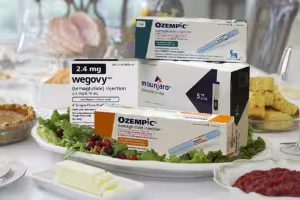
Risky Business: How to Protect Your Health While Building Your Empire
by Alice Benjamin
The healthcare landscape is continuously evolving, particularly in the treatment of chronic conditions like obesity. Recently, Eli Lilly announced a significant development: the availability of starter doses of the weight-loss drug Zepbound in single-dose vials. This move, designed to meet the surging demand for this medication, is a double-edged sword. While it potentially increases accessibility for patients, it also brings with it a heightened risk of harm and medication errors. As healthcare providers, it’s imperative to examine this development closely, understand the motivations behind it, and educate our patients on how to navigate these changes safely.
Why the Change? The Demand for Obesity Medications
Obesity has been recognized as a serious chronic illness with long-term health consequences, including increased risks for cardiovascular disease, diabetes, and certain cancers. Despite this, obesity is often misclassified as a lifestyle choice, leading to significant gaps in insurance coverage for medications that can help manage this condition. As a result, many patients are forced to pay out of pocket for their treatments, making accessibility a major concern.
In recent years, a new class of medications, including tirzepatide, the active ingredient in Zepbound and its sister drug Mounjaro, has transformed the landscape of obesity and diabetes management. These drugs have shown remarkable efficacy in helping patients achieve significant weight loss and improve metabolic health. However, their popularity has led to widespread shortages, driving some patients to seek alternatives from compounding pharmacies—an option fraught with risks.
Eli Lilly’s decision to introduce single-dose vials of Zepbound is a direct response to this high demand and the resulting shortages. By offering these vials, the company aims to expand the supply of this critical medication and provide a more affordable option for patients who may not qualify for existing savings programs. The vials are available exclusively through LillyDirect, a platform that helps coordinate telehealth services and prescription fulfillment, allowing patients to access their medication without the intermediary of traditional insurance.
What Patients Need to Know About the New Vials
The introduction of single-dose vials is not without its challenges. Unlike preloaded injector pens, which are user-friendly and designed to minimize the risk of dosing errors, these vials require patients to manually draw out their medication using a syringe. This method, while not inherently complex, introduces several potential pitfalls that patients need to be aware of.
The Risk of Medication Errors
One of the most significant concerns with the use of single-dose vials is the potential for medication errors. Drawing up the correct dose of medication from a vial requires a level of precision that some patients may find difficult to achieve. This is particularly true for those who are elderly, have limited dexterity, or suffer from poor vision—populations that are already at increased risk for medication-related complications. The vial is designed to be used only once; after the dose is drawn out with a syringe and administered, the remaining contents, if any, are discarded, and the vial is disposed of.
The FDA has recently issued warnings about compounded versions of similar medications, such as semaglutide, due to reports of adverse events stemming from dosing errors, varying product concentrations, and the use of multiple-dose vials. These issues underscore the importance of patients using only FDA-approved medications from verified sources.
Eli Lilly has echoed these concerns, emphasizing that they are the only lawful supplier of FDA-approved tirzepatide medicines. The company has warned that products from other sources may be counterfeit or otherwise unsafe, potentially leading to serious health consequences.
The Learning Curve for Patients
For many patients, the transition from a preloaded pen to a syringe and vial may represent a significant learning curve. While some may find this method straightforward, others may struggle with the mechanics of drawing up their medication accurately. This can be particularly daunting for those who have never used a syringe before or who have been managing their condition with the convenience of an auto-injector.
As healthcare providers, it is our responsibility to ensure that patients are properly educated on how to use these new vials safely. This includes providing clear instructions on how to draw up the correct dose, recognizing the signs of potential adverse effects, and understanding the importance of using approved medications from reputable sources. Additionally, it may be beneficial to offer training sessions or instructional materials to help patients build confidence in using these new vials.
The Potential Benefits of Single-Dose Vials
Despite the challenges, there are potential benefits to using single-dose vials. For one, they offer a degree of flexibility that preloaded pens do not. Patients who are starting at lower doses or who are experiencing side effects may find it advantageous to be able to draw up a smaller amount of medication. This flexibility can help tailor the treatment to the patient’s specific needs and tolerance levels.
Moreover, the lower price point of these vials—$399 for a four-week supply of 2.5 mg vials and $529 for 5 mg vials—makes them more accessible to patients who might otherwise struggle to afford their medication. This is particularly important given the high cost of GLP-1 medications for obesity, which can be prohibitive for many individuals, especially those without insurance coverage.
Navigating the Transition Safely
For patients who are considering transitioning to single-dose vials, it is crucial to do so under the guidance of a healthcare provider. Here are some key points that patients should keep in mind to ensure they navigate this change safely:
Proper Training: Before switching to single-dose vials, patients should receive thorough training on how to draw up their medication accurately. This can include in-person demonstrations, instructional videos, or printed materials that clearly outline each step of the process.
Double-Check Dosages: Patients should always double-check their dosage before administering the medication. If there is any uncertainty, they should consult their healthcare provider for clarification.
Recognize Adverse Effects: Patients should be educated on the potential side effects of tirzepatide and encouraged to monitor their response to the medication closely. If they experience any unusual symptoms, they should seek medical advice promptly.
Verify Medication Sources: It is vital that patients obtain their medication from a reliable source, such as LillyDirect, to ensure they are receiving an FDA-approved product. They should be wary of compounded versions or medications obtained from unverified sources.
Infection Control: When accessing and administering medication from a single-dose vial, it’s crucial to follow proper infection control practices. This includes using a sterile syringe and needle for each injection, cleaning the vial’s rubber stopper with an alcohol swab before drawing up the medication, and ensuring that the injection site is also properly disinfected. These steps help minimize the risk of infections, which can occur if bacteria are introduced during the injection process.
Consult with a Healthcare Provider: Patients should maintain regular communication with their healthcare provider, particularly during the initial stages of using single-dose vials. Any concerns or difficulties should be discussed immediately to prevent potential complications.
The introduction of single-dose vials for Zepbound represents a significant shift in the management of obesity, offering greater accessibility and flexibility for patients. However, this change also comes with increased risks, particularly related to medication errors and the challenges of self-administration. As healthcare providers, our role is to ensure that patients are well-informed and equipped to manage these new vials safely. By providing comprehensive education and support, we can help our patients navigate this transition successfully while minimizing the potential for harm.
Ultimately, the drive to make medications more accessible should always be balanced with a commitment to patient safety. By remaining vigilant and proactive, we can support our patients in achieving their health goals without compromising their well-being.




